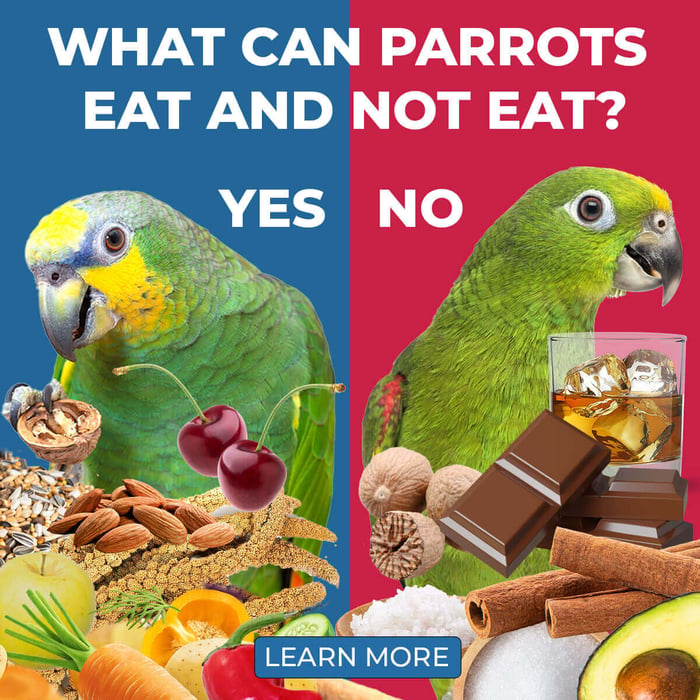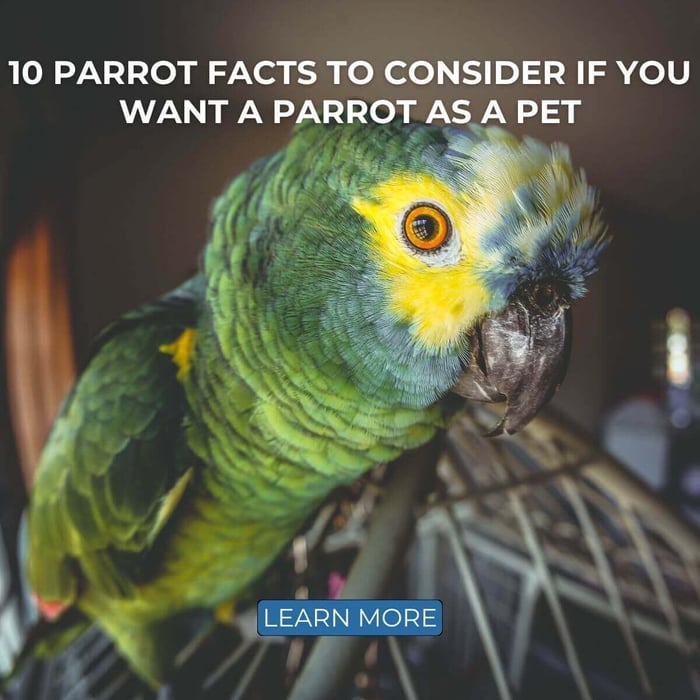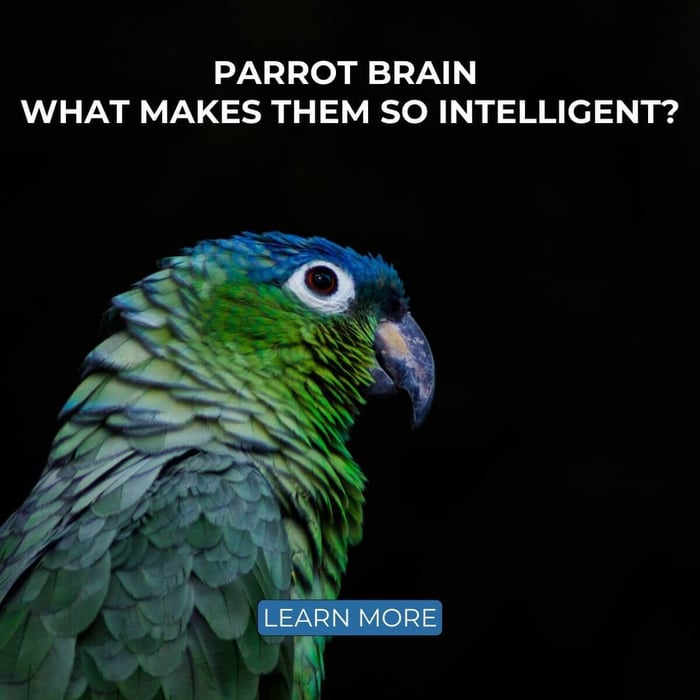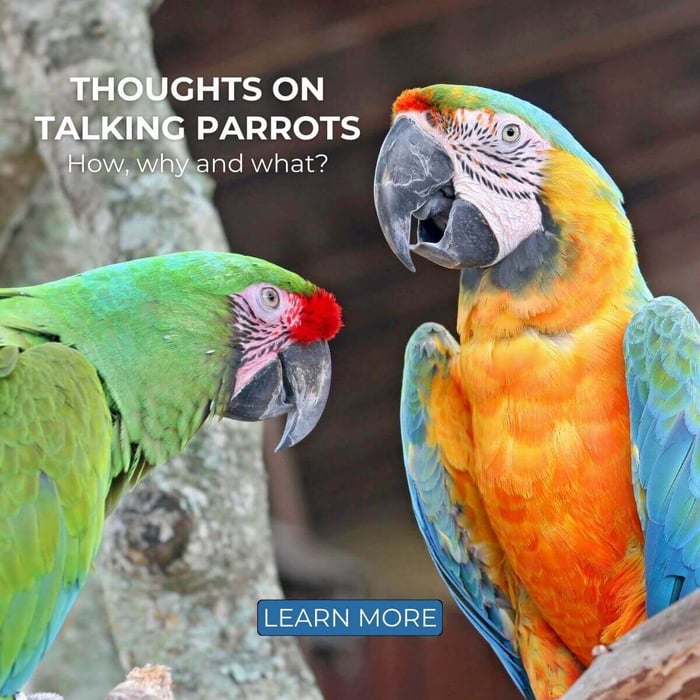Which Parrot Species Should You Choose?
If you are thinking about buying your first type of parrot species, don’t think too big! First-time parrot buyers often start too ambitiously and end up realizing they literally cannot handle such a large bird after all.
The story gets even more complicated if the new owner still feels a bit ambivalent about owning a parrot. Unfortunately, it is common in these situations for people to be frightened of potential injury, so they don’t allow their parrot out of the cage. This is a sure way of condemning your parrot to a poor quality of life.
On the other hand, small parrots don’t seem to concern their owners that much. From the pet bird keeper’s point of view, they have various advantages over larger ones. They are relatively inexpensive to feed, and large, expensive accommodation is not a necessity.

The wisest newcomers to parrot-keeping usually chose one of the parrot species from this group. In most cases, Small parrot species are readily available at a reasonable or even low price, which indicates that they are easy to breed. You can often find them in a range of colour mutations, and many of them are incredibly beautiful. Long story short, they might be the perfect option for your parrot-keeping 101?
Even though these parrots are small, they appreciate human companionship just as much as larger parrot species. In fact, most small parrots are highly sociable, so it might be a good idea to purchase them the same species companion. If you decide to do this, make sure to buy the other parrot at the same time or soon after the first one.
Having two parrots at the same time will offer you an opportunity to observe their behaviour from a different angle. Seeing them interact with each other can be enjoyable. In my opinion, a single Lovebird or parrotlet left alone for hours is the saddest thing you can witness. However, if they have a close bond with their human caregiver, solitude won’t be so tough.
So, if we can agree that buying a Macaw as your first parrot is not the most sensible thing to do and that starting small makes sense, which species should you consider? Before you decide on the species that will be the best fit for your household, read more information about them and then make a smart choice.
Single bird or a pair?

As we already mentioned, a single parrot is often lonely. Buying a single pet is a legitimate choice only if you can spend much time with it daily. Still, what if you purchase a pair? Are you ready to breed them? The market for particular parrot species is already saturated, which is one of the reasons why some owners don’t like the idea of having to part with the young.
As we know, many small parrots are inexpensive and prolific. If their value is low, it becomes difficult to find them appropriate homes where their quality of life won’t be questionable. In the majority of species, two males are capable of living happily together. At the same time, in most parrot species, more males are available on the market as fewer females are bred.
Two females might also be compatible, but there is an exception to this rule. If the species is female-dominant, like Lovebirds or a Poicephalus parrot such as a Senegal or Meyer’s, for example, matching two females might become a problem.
If you are living in a small space and your pet has a limited area to explore, going with Celestial or Pacific parrotlets (Forpus coelestis) might be a good idea. They are smaller than Lovebird, curious and bold when hand-reared. Also, you can easily determine their sex by observing their plumage. They can bond strongly with their human companion; they are good at mimics and very entertaining while they play with their toys.
Acquiring new parrots

Buying a second bird should never be a subject of impulse shopping. Thorough planning and adequate preparations need to be done. Every new bird that enters your house carries with it the risk of disease. For most parrots, moving to a new home is a very stressful experience that can trigger symptoms of any underlying disease problem. Maintaining a period of isolation and observation is part of the necessary precaution – plus a recommended visit to an Avian vet.
You should understand that parrots of all species and sizes are highly territorial and possessive regarding their cages. If you place the second bird in your pet’s cage, you are risking stress, serious injury or even death.
Please remember that your relationship with your parrot can also be compromised or destroyed by the acquisition of a second bird due to jealousy. However, the benefits of providing a bird companion to your pet can be numerous.
When they reach maturity, some small parrots stop being good pets, and seemingly, they need a mate. For others, their human is a fair enough substitute. There are no strict rules that always apply. If you want to be a good parrot owner, you’ll need to learn how to observe and understand your pet’s behaviour.
Keeping both a male and a female of a prolific parrot species, such as the Lineolated or Bourke’s Parakeet and Peach-faced Lovebird, with all of the basic requirements for breeding, means that at some point, they will probably produce young.
Parting with the young might be hard for you from the emotional point of view – but if you aim to provide optimal living conditions for your pets, there is a limit to the number you can care for.
Sexing
Determining sex in some parrot species is almost impossible because of their outward appearance and behaviour. However, all parrots can be sexed using DNA technology. Taking a few feathers or a drop of blood and sending them to an avian diagnostic laboratory is all you have to do.
Remember, in smaller species, DNA sexing can cost almost as much as the bird itself.
Species suitable for home

Although some parrot species are especially recommended for first-time owners, you should remember that the crucial factors are acquiring a young bird and always working on developing and maintaining a loving relationship with it, which doesn’t happen overnight and requires a lot of patience.
Species guides can be handy if you are looking for a single, small or medium-sized companion parrot. Green-cheeked (and other Pyrrhura conures – Maroon-bellied, for example), Nanday and Mitred Conures, Senegal parrot and Hahn’s Macaw are all ideal for first-timers. If you are wishing for a bird with plenty of character, consider the Quaker Parakeet.
Small Conures probably won’t learn to mimic, while if you purchase a Quaker, you can expect to have an excellent loud “talker.” When the Quaker is hand-reared and receives a lot of attention, his noise level usually doesn’t become intolerable.
However, every parrot species, except little parrotlets and Lineolateds, will be loud from time to time. So, consult with all of your family members (and perhaps neighbours?) before purchasing one.
Hand-reared Lovebirds can also make decent pets, but their potential is hard to assess when they are still young. If you want to keep them tame, you need to handle them every day.
Cockatiels have the potential to be cute pets, and their males have a talent for mimics.
If you are planning on spending a significant amount of money on a parrot that is around 25 cm large, short-tailed true parrots, Pionus parrots, and Black-headed Caiques are the ones you should consider.
Caiques will keep you laughing; they are strong-willed, clownish extroverts. Pionus (such as Maximilian’s), are more relaxed and easygoing. Both breeds are significantly less demanding than larger parrots.
If you have long working hours and a number of other commitments during the day that keep you out of the house for hours, don’t even consider a Grey or an Amazon parrot, Cockatoo or Macaw. They need as much attention and devotion as you would offer to a child.
Poicephalus parrots, with Senegal and the Meyers as representatives of the class, can sometimes make good pets, especially when they are young. However, their temperament is unpredictable; some are enchanting, and some are too needy and difficult to handle. They often attach themselves to one member of the household and avoid others.
Which parrot species are unsuitable as pets?
Some parrot species are simply not suited to cage life. Even though Rosellas (Golden-mantled Rosella, for example) might attract you with their colours, if you don’t have an aviary, don’t purchase them because they shouldn’t be kept in a cage.
Kakarikis (New Zealand Parakeets) are energetic, amusing aviary birds but equally unsuited for a cage. Although they are popular in today’s market, don’t buy them if you cannot provide the right conditions.
How to buy the right cage?

Whichever parrot you choose, be ready to give more money for the cage than the bird itself. Buying a smaller cage to save some cash is a bad idea.
Small parrots that are highly active (like Caiques) will need a larger cage in proportion to their size than the large ones. There has to be enough space for their swings and ropes too.
The width of the cage is a measurement that matters. It should be at least four times the width of a bird’s opened wings or even larger if we are talking about Lovebirds and parrotlets. The depth needs to be at least twice the bird’s length with fully opened wings.
Exercise is gained by flying from perch to perch, which is the reason why the cage’s height is less important. Cylindrical cages look beautiful but they are not healthy for your pet, so you must avoid them.
The feature you should look for when it comes to buying a cage is castors. This allows you to move around your home more quickly.
Small cages are unacceptable and the fact that you will allow your parrot out at least once a day it is not good enough excuse to purchase them. Cramped spaces might make your parrot aggressive out of fear or territoriality.
Many Conures and Caiques feel safe in dark, cosy corners, and they choose to retreat into a small wooden nestbox or a little cloth bag. That is why they will often try to make a bed under the newspaper on the cage floor. Some small species, like Lovebirds, Lineolated Parakeets, and parrotlets, feel more secure in box-shaped cages, which are only open at the front.
Choosing perches and wood for gnawing
Natural wood parrot perches are highly recommended for all of the species. If you purchase a cage with plastic perches, make sure to replace at least one of them a with a dowel or apple and pear tree branch.
Willow is soft, and if you use it for perching, it needs to be replaced regularly. However, it is excellent for Lovebirds to make their nest with it.
Many parrots prefer surprisingly thin perches. Once the pole becomes shiny and uncomfortable, you have to replace it because constant clutching to a perch of the same circumference can be damaging for your parrot’s feet. Also, don’t forget to wash them frequently.
If you have a garden, plant an apple or pear tree and a quick-growing eucalypt, such as Eucalyptus gunni. This will offer your bird ideal materials for gnawing.
What are the most challenging species?

Grey parrots seem to be one of the most difficult to keep in a pet situation. They are extremely sensitive. Stress often causes feather plucking among them. Their high intelligence also makes them capable of dominating their human companions if they are not properly socialised and trained. Using positive reinforcement is excellent for training pet parrots, with excellent and long-lasting results.
Smaller parrots usually don’t engage in feather plucking, except for Lovebirds and Poicephalus species such as the Senegal. However, almost any parrot can start plucking itself in a permanently stressful situation.
Thoughts on wing-clipping
Under normal circumstances, this practice shouldn’t be performed. Even though some parrots like Caiques, which are not strong flyers, are not significantly affected by this change, depriving a bird of its ability to fly is still cruel.
If you want your parrot to remain healthy over its full lifespan (which is 20-30 years in most cases of smaller species), they need to fly. The sole act of flying keeps their muscles and heart in good condition. Wing-clipped birds often become overweight.
However, every bird must be carefully supervised when letting out of its cage. There are too many hazards in its surroundings. A play stand should be the centre of the bird’s attention to keep it out from other areas where it might get in trouble. Climbing on the curtains, perching on the top of a door or nibbling the spines of books can all be dangerous.
Remember – putting a chain screen on the doors that are most frequently used in your house might save your parrot’s life.
If you want to learn more about parrots in Rosemary Low’s species guides, visit her website: www.rosemarylow.co.uk




